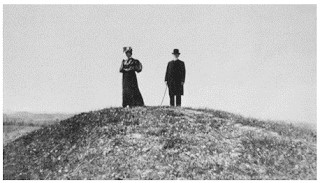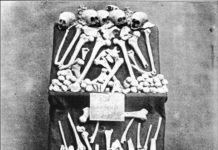Understanding the word Cumorah and when it was first understood as the hill in upstate New York seems to be an area of discussion lately. I believe there is only one Hill Cumorah in upstate New York and that name “Cumorah” was understood by Joseph Smith before he translated the plates. I believe near and around the Hill Cumorah the final battles were fought by the Nephites, and so were the final battles of the Jaredites, hundreds of years earlier. (Hill Ramah). I believe not only was there the place of the stone box where Joseph found the plates at Hill Cumorah, but there was also a separate cave in Hill Cumorah, where Joseph Smith and others visited and saw wagon loads of plates in a large room. You will read below this information about Cumorah from the blogs of Jonathan Neville.
| Presidents Joseph F. Smith and George Albert Smith on Cumorah |
The LDS scholars who continue to promote the Mesoamerican setting like to say Joseph Fielding Smith didn’t know what he was talking about when he denounced the two-Cumorah theory. They say the same about two other Presidents of the Church: Joseph F. Smith and George Albert Smith. See my comments at the end of this post.
“We visited the Hill Cumorah and were accorded the courtesy of going thereon by the wife of Mr. George Sampson, a brother of Admiral Wm. Sampson, who before his death owned the property. When we went up there and looked around, we felt that we were standing on holy ground. The
brethren located, as near as they thought was possible, the place from which the plates of the Book of Mormon were taken by the Prophet. We were delighted to be there. Looking over the surrounding country we remembered that two great races of people had wound up their existence in the vicinity, had fought their last fight, and that hundreds of thousands had been slain within sight of that hill.
Evidence of the great battles that have been fought there in days gone by are manifest in the numerous spear and arrow-heads that have been found by farmers while plowing in that neighborhood. We were fortunate enough to obtain a few of the arrowheads. Upon the hill, near a
little grove of timber, the party stood and sang that glorious hymn:
An angel from on high
The long, long silence broke;
Descending from the sky,
These gracious words he spoke:
Another report of the trip explained that President Smith’s prayer was not recorded:
“They visited the Hill Cumorah, from which place a most excellent view of the country round is afforded. The party of course was reminded of the great and final battle of the Jaredites which took place around this hill, and later between the Lamanites and Nephites, and as souvenirs some of them brought flint arrow heads, which are continually being gathered now and sold as souvenirs. Prayer was offered on the hill and the site was pointed out as near as possible where the plates from which the Book of Mormon was translated were concealed. President Smith offered the prayer, but much to the regret of all it was not reported.”
http://lds-church-history.blogspot.com/2012/01/george-albert-smith-january-4-1906.html
For more history about Cumorah, go here:
http://publications.mi.byu.edu/publications/jbms/13/1/5101b46407de713-1-2.pdf
Another report of the trip explained that President Smith’s prayer was not recorded:
“They visited the Hill Cumorah, from which place a most excellent view of the country round is afforded. The party of course was reminded of the great and final battle of the Jaredites which took place around this hill, and later between the Lamanites and Nephites, and as souvenirs some of them brought flint arrow heads, which are continually being gathered now and sold as souvenirs. Prayer was offered on the hill and the site was pointed out as near as possible where the plates from which the Book of Mormon was translated were concealed. President Smith offered the prayer, but much to the regret of all it was not reported.”
http://lds-church-history.blogspot.com/2012/01/george-albert-smith-january-4-1906.html
For more history about Cumorah, go here:
http://publications.mi.byu.edu/publications/jbms/13/1/5101b46407de713-1-2.pdf
Lo! in Cumorah’s lonely hill,
A sacred record lies concealed.
“And then, under the inspiration of the Lord, President Smith offered one of the most profound and beautiful prayers I have ever listened to. Everyone present was melted to tears. We felt the presence of the Spirit of our Father; and all who were there can testify that it was one of the most supremely happy moments of their lives.”
____________________________
Over a hundred years later, some prominent LDS scholars still insist Parley P. Pratt, who wrote the words to that hymn (which is still in our hymnal), was merely repeating a false tradition started by unknown early Church members, because the “real” Hill Cumorah is somewhere in Mexico.
These scholars insist Joseph F. Smith, George Albert Smith, and Joseph Fielding Smith didn’t know what they were talking about. They insist these men, like Joseph Smith himself, adopted and embraced the false tradition that Cumorah is in New York.
These scholars insist the hill in New York is “clean” with no artifacts.
These scholars, including the contributors to FairMormon, Book of Mormon Central, theInterpreter, and the rest of the scholarly publications, insist the hill Cumorah is actually somewhere in Mexico, although they’re not sure where. Other scholars insist the hill Cumorah is in Baja, or Panama, or elsewhere–just so long as it is not in New York.
Again, regarding the Hill Cumorah in New York, it’s a clear choice: Joseph Smith, Oliver Cowdery, Joseph F. Smith, George Albert Smith, and Joseph Fielding Smith vs. modern LDS scholars.
____________________________
Source: Letter VII
Jonathan Neville | URL: http://wp.me/p741A5-iJ


 From a faithful perspective we review the new book series Saints, published by the Church Historian’s Press. To make the book more useful for readers, we offer supplemental materials and comments in response to an editorial agenda that obscures some important faith-affirming events.
From a faithful perspective we review the new book series Saints, published by the Church Historian’s Press. To make the book more useful for readers, we offer supplemental materials and comments in response to an editorial agenda that obscures some important faith-affirming events.




